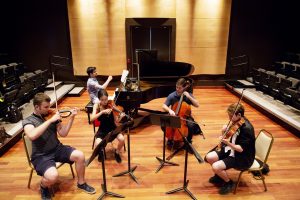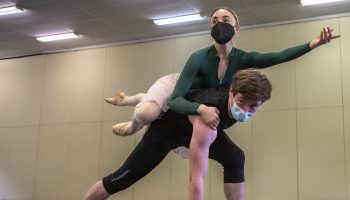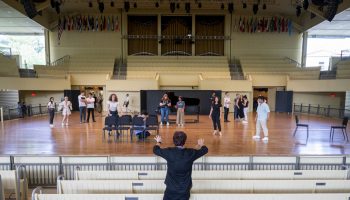
Fans of chamber music will have plenty to look forward to this week, as students in the School of Music come together to offer four full recitals of small ensemble performances.
Nearly all students in the Music School Festival Orchestra and about half the students in the School of Music Piano Program will join forces throughout the week in Phase 1 of student chamber music performances. The first of these concerts is at noon today in Fletcher Music Hall.
Playing chamber music is an important part of any young musician’s education and training, said Kathryn Votapek, chair of chamber music and Instrumental Program faculty. Though students in the MSFO spend much of their time performing as part of the whole orchestra, playing chamber music in a small group provides them with a completely different experience.
“Playing in an orchestra develops certain skills, (and) playing chamber music develops other skills,” Votapek said.
School of Music faculty decide who is in each group and what piece each group will play. Members of each group must deal with the challenges of playing with new people and playing pieces they may be previously unfamiliar with. The pieces were chosen from a repertoire suggested by the pianists, who had to know what they would play farther in advance because their parts take longer to learn.
Phase 1 of student chamber music lasts all through this week and the beginning of next week; there are four concerts in total — one at noon today, July 16, one at 7 p.m. Friday, one at 7 p.m. Saturday (all in Fletcher) and the last at 4 p.m. Sunday in McKnight Hall.
“Phase 1” means this is the first of two weeks of chamber music that the students in the Instrumental Program will put on this season. This week, the 19 chamber music groups include several groups with students from the Piano Program.
For Phase 2, which will take place during Week Six, these groups will be reshuffled and the piano students will no longer be involved. Additionally, in Phase 1 most of the groups will only be performing parts of larger works, whereas in Phase 2 they will play the entirety of longer pieces.
“I think, in many ways, this is the most important part of the student’s education — not to take away from individual lessons, not to take away from orchestra, but it’s different when you have to play with other people rather than just play by yourself,” Votapek said. “You have to bring your very best to the group, and yet you have to be able to listen to what other people are saying and thinking and doing, and respond to that.”
Five chamber music groups will play in today’s recital. The pieces on the program are Grazyna Bacewicz’s “Quartet for Four Violins,” Samuel Barber’s Summer Music for Wind Quintet, Op. 31, Cesar Franck’s Piano Quintet in F minor, Camille Saint-Saëns’ Fantaisie in A Major, Op. 124 and Johannes Brahms’ Piano Quintet in F Minor, Op. 34.
In addition to the difficulties that come from playing with new musicians and unfamiliar pieces, many of the groups have different combinations of instruments, so each type of ensemble comes with its own difficulties.
Masayoshi Arakawa, one of the four violinists playing Bacewicz’s quartet, said that playing in an all-violin group is more difficult than playing in a mixed string ensemble. Without another type of string to vary the timbre of the ensemble, all four players must be very precise in their tones.
“We have to get our sound exactly in the same realm,” Arakawa said. “With a violin and a cello, the timbres are different, so there’s no need to perfectly match how our sounds are. But with four violins, if one person gets just slightly off then it sounds extremely unbalanced. So matching each other has been a big challenge.”
Though the chamber music groups have had only a few weeks to practice together, they’ve been able to come together in a short time to work in cohesion.
Dominic Muzzi, a pianist in the group playing the Francks piece along with a cellist, a violist and two violinists, has been playing chamber music for about 10 years, and knows that meshing well with the other members in an ensemble isn’t a given.





